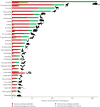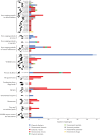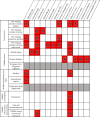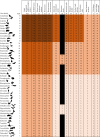Wildlife Pathogens and Zoonotic Disease Risk Assessment in Vietnam: A Wildlife Trade Hotspot
- PMID: 40574985
- PMCID: PMC12202080
- DOI: 10.1155/tbed/4926262
Wildlife Pathogens and Zoonotic Disease Risk Assessment in Vietnam: A Wildlife Trade Hotspot
Abstract
Vietnam is a wildlife trade hotspot presenting multiple high-risk interfaces for pathogen spillover from wildlife to humans. However, the zoonotic disease risk remains poorly characterized in the country and needs to be assessed to better inform policy dialog and legislative reforms. A literature review was conducted to create a pathogen inventory of terrestrial vertebrates in Vietnam. Additionally, data from an existing global database were used to estimate the number of zoonotic pathogens found in different families. The literature review yielded 87 eligible records. A total of 162 pathogen species, including 22 parasites, 48 bacteria, two fungi, eight protozoans, and 82 viruses, were recorded in Vietnam in 46 families of terrestrial vertebrates belonging to four classes and 18 orders. The highest number of pathogens was observed in Muridae (rats and mice), followed by Pythonidae (pythons) and Cercopithecidae (Old World monkeys). A total of 12 out of 29 priority zoonoses in Vietnam were reported in 27 terrestrial wildlife host families. Zoonotic pathogens were reported at 11 human-wildlife interfaces. Most detections of priority zoonotic pathogens were made in free-ranging animals as well as in wildlife farms and primate facilities. A risk assessment, based on the number of zoonotic pathogens found, suggested that facilities with a very high risk of zoonotic spillover include bushmeat markets in cities and town, wildlife farms, restaurants and rescue centers engaged in trading, housing and breeding birds belonging to the Columbidae, Phasianidae, Ardeidae families, and mammals belonging to the Cervidae, Suidae, Felidae, Ursidae, Mustelidae, Cercopithecidae, Muridae, and Sciuridae families. These supply chain nodes where wildlife families are in contact with human populations should be strictly regulated and monitored, with stricter biosecurity measures. Breeding of several species belonging to high-risk and medium-risk wildlife families together in the same captive facility should be banned to reduce the risk of pathogen-host jumps.
Copyright © 2025 Alice Latinne and Pawin Padungtod. Transboundary and Emerging Diseases published by John Wiley & Sons Ltd.
Conflict of interest statement
The authors declare no conflicts of interest.
Figures








References
-
- WHO. WHO Covid-19 Dashboard. 2024. https://Data.Who.Int/Dashboards/Covid19/Cases .
Publication types
MeSH terms
LinkOut - more resources
Full Text Sources
Medical

